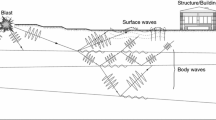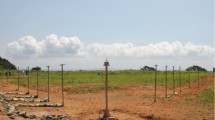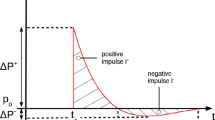Abstract
Detailed blast propagation and evolution through multiple structures representing an urban environment were simulated using the code Loci/BLAST, which employs an overset meshing strategy. The use of overset meshes simplifies mesh generation by allowing meshes for individual component geometries to be generated independently. Detailed blast propagation and evolution through multiple structures, wave reflection and interaction between structures, and blast loadings on structures were simulated and analyzed. Predicted results showed good agreement with experimental data generated by the US Army Engineer Research and Development Center. Loci/BLAST results were also found to compare favorably to simulations obtained using the Second-Order Hydrodynamic Automatic Mesh Refinement Code (SHAMRC). The results obtained demonstrated that blast reflections in an urban setting significantly increased the blast loads on adjacent buildings. Correlations of computational results with experimental data yielded valuable insights into the physics of blast propagation, reflection, and interaction under an urban setting and verified the use of Loci/BLAST as a viable tool for urban blast analysis.













Similar content being viewed by others
References
Thompson, D., Luke, E., Remotigue, M., Janus, M., Wang, X., Collins, E., Arnoldus, Q., Trcalek, M., Weed, R., Moore, C., Tong, X.: Multi-Fidelity Tools for Blast Analysis in Urban Environments. SERRI Report 90028-01, Oak Ridge National Laboratory (2012)
Thompson, D., Janus, J.M., Luke, E., More, E., Remotigue, M., Tong, X.L., Weed, R., Ivancic, P.: Enhanced Simulation of Blast-Vehicle Interactions using Loci/BLAST and LS-DYNA. Final Report for SimBRS WD 0034, Contract No. W56HZV-08-C-0236 (2012)
Thompson, D., Luke, E., Newman III, J.C., Janus, M., Blades, E., Tong, X., Moore, C.: Development of a Strategy for Simulating Blast-vehicle Interactions. TACOM/TARDEC Report 21200RC. U.S. Army Tank Automotive Research Development and Engineering Center, Warren, MI (2010)
Ivancic, P., Janus, J.M., Luke, E., Thompson, D., Weed, R., Kang, J.: A Conformal, Fully-Conservative Approach for Predicting Blast Effects on Ground Vehicles. NATO Paper MP-AVT-221-05, Design and Protection Technologies for Land and Amphibious NATO Vehicles, Copenhagen, DK, Apr 7–9 (2014)
Meakin, R.: Composite overset structured grids. In: Thompson, J., Soni, B., Weatherill, N. (eds.) The Handbook of Grid Generation, vol. 11-1. CRC Press (1999)
Crepeau, J.: SHAMRC Second-Order Hydrodynamic Automatic Mesh Refinement Code, vol. 2. User’s Manual. Applied Research Associates, Inc., Albuquerque, NM (1998)
Fairlie, G.E.: Efficient Analysis of High Explosive Air Blast in Complex Urban Geometries Using the AUTODYN-2D & 3D Hydrocodes, Analytical Experiments and Methods. In: 15th International Symposium on Military Application of Blast and Shock, MABS 15, Sep. 1997, Banff, Canada (1997)
Wrobel, K., Schultz, P., Crawford, D.: An atmospheric blast/thermal model for the formation of high-latitude pedestal craters. Meteorit. Planet. Sci. 41(10), 1539–1550 (2006)
Jiang, D., Liu, Y., Qi, C., Ma, Z., Raju, B., Bryzik, W.: Innovative Composite Design for Blast Protection. SAE World Congress and Exhibition, 2007-01-0483 (2007)
Alia, A., Souli, M.: High explosive simulation using multi-material formulations. Appl. Therm. Eng. 26(10), 1032–1042 (2006)
Chafi, M.S., Karami, G., Ziejewski, M.: Numerical analysis of blast-induced wave propagation using FSI and ALE multi-material formulations. Int. J. Impact Eng. 36(10–11), 1269–1275 (2009)
McGlaun, J.M., Thompson, S.L., Elrick, M.G.: CTH: a three-dimensional shock wave physics code. Int. J. Impact Eng. 99, 351–360 (1990)
Crepeau, J., Needham, C., Hikida, S.: SHAMRC Second-Order Hydrodynamic Automatic Mesh Refinement Code, vol. 1: Methodology. Applied Research Associates, Albuqurque, NM (2001)
Luo, H., Baum, J.D., Löhner, R., Cabello, J.: Adaptive edge-based finite element schemes for the Euler and Navier–Stokes Equations. AIAA Paper 1993-0336 (1993)
Baum, J.D., Luo, H., Löhner, R.: Numerical simulation of blast in the World Trade Center. AIAA Paper 95-0085 (1995)
Rice, D.L., Baum J.D., Togashi, F., Löhner, R., Amini, A.: First-principles blast diffraction simulations on a notebook: Accuracy, resolution and turn-around issues. In: Proceedings of the 20th International Symposium on Military Aspects of Blast and Shock, MABS 20, Sep. 2008, Oslo, Norway (2008)
Gittings, M.L., Weaver, R.P., Clover, M., Betlach, T., Byrne, N.: The Rage Radiation- Hydrodynamic Code. Los Alamos National Laboratory Report LA-UR-06-0027. Los Alamos, NM (2006)
Schlamp, R.J., Hassig, P.J., Nguyen, C.T., Hatfield, D.W., Hookham. P.A.: MAZ User’s Manual. Technical Report DNA001-91-C-0153. Defense Nuclear Agency, Washington, DC (1995)
Ripley, R., Cloney, C., Donahue, L., Frost, D.L., Zhang, F.: Enhanced loading due to reflected heterogeneous blast. In: Proceedings of the 21st International Symposium on Military Aspects of Blast and Shock, MABS 21, Oct. 2010, Jerusalem, Israel (2010)
Century Dynamics. AUTODYN-2D & 3D User’s Manual (2003)
Cowler, M.S., Quan, X., Fairlie, G.E.: A computational approach to assessing blast damage in urban centers using AUTODYN. In: Paper PVP2004-3044, ASME/JSME 2004 Pressure and Piping Conference (2004)
Nichols, A.: User Manual for ALE3D: An Arbitrary Lagrangian-Eulerian 3D Code System. Technical Report, UCRL-MA-152204 Rev. 6. LLNL, Livermore, CA (2007)
Hallquist, J.O.: LS-DYNA Theory Manual. Livermore Software Technology Corporation, Livermore (2006)
Hyde, D.W.: User’s Guide for Microcomputer Programs CONWEP and FUNPRO, Applications of TM5-855-1. Instructional Report SL-88-1. U. S. Army Engineering Research and Development Center, Vicksburg, MS (1991)
Bessette, G., Vaughn,C., Bell, R., Yarrington, P., Attaway, S.: ZAPOTEC: A Coupled Eulerian-Lagrangian Computer Code, Methodology and User Manual, Version 1.0. Sandia Technical Report. Sandia National Laboratories, Albuquerque, NM (2003)
McKeown, R., Dengel, O., Harris, G., Diekhoff. H.J.: Development and Evaluation of DYSMAS Hydrocode for Predicting Underwater Explosion Effects, Executive Summary, vol. 1 IHTR 2492. Naval Surface Warfare Center, Indian Head, MD (2004)
Luke, E., Cinnella, P.: Numerical simulations of mixtures of fluids using upwind algorithms. Comput. Fluids 36, 1547–1566 (2007)
Lee, E., Tarver, C.: Phenomenological model of shock initiation in heterogeneous explosives. Phys. Fluids 23, 2362–2372 (1980)
Veluri, S., Roy, C.J., Luke, E.: Comprehensive Code Verification for an Unstructured Finite Volume CFD Code. In: 48th AIAA Aerospace Sciences Meeting, January 4-7, 2010, Orlando FL, AIAA Paper 2010-127 (2010)
Li, Y.-H.: Equation of state for water and sea water. J. Geophys. Res. 72(10), 2665–2678 (1967)
Fiserova, D.: Numerical analysis of buried mine explosions with emphasis on effect of soil properties on loading. PhD Thesis, Cranfield University (2006)
Einfeldt, B.: On Godunov-type methods for gas dynamics. SIAM J. Numer. Anal. 25(2), 294–318 (1988)
Barth, T.J., Jespersen, D.C.: The design and application of upwind schemes on unstructured meshes. AIAA Paper 1989-0366 (1989)
Shu, C.-W., Osher, S.: Efficient implementation of essentially non-oscillatory shock-capturing schemes. J. Comput. Phys. 77(2), 439–471 (1988)
Chalasani, S., Senguttuvan, V., Thompson, D., Luke, E.: On the use of general elements in fluid dynamics simulations. Commun. Numer. Methods Eng. 24(6), 435–448 (2008)
Togashi, F., Nakahashi, K., Ito, Y., Iwamiya, T., Shimbo, Y.: Flow simulation of NAL experimental supersonic airplane/booster separation using overset unstructured grids. Comput. Fluids 30, 673–688 (2001)
Acknowledgments
This research was partially funded by the Department of Homeland Security-sponsored Southeast Region Research Initiative (SERRI) at the Department of Energy’s Oak Ridge National Laboratory.
Author information
Authors and Affiliations
Corresponding author
Additional information
Communicated by C. Needham.
Rights and permissions
About this article
Cite this article
Wang, X., Remotigue, M., Arnoldus, Q. et al. High-fidelity simulations of blast loadings in urban environments using an overset meshing strategy. Shock Waves 27, 409–422 (2017). https://doi.org/10.1007/s00193-016-0680-x
Received:
Revised:
Accepted:
Published:
Issue Date:
DOI: https://doi.org/10.1007/s00193-016-0680-x




